50 facts about The Duke of Edinburgh
Published
THE FOLLOWING STATEMENT IS ISSUED BY THE PRESS SECRETARY TO THE QUEEN
Buckingham Palace today released 50 facts about the life and work of The Duke of Edinburgh, particularly in support of The Queen. This list is intended to be used as a source of information, and does not aim to emphasise any particular aspects of Prince Philip's work. The facts were taken from records held at Buckingham Palace.
1. The Duke of Edinburgh was born at the villa 'Mon Repos', the summer retreat of the Greek royal family, on the island of Corfu, on 10th June 1921.
2. The Duke is the youngest child and only son of Prince Andrew of Greece and Princess Alice (of Battenberg). His grandfather was a Prince of Denmark who became King of Greece. The Duke is also related to Kings of Prussia and Emperors of Russia. The Duke renounced his Greek royal title in 1947 and became a naturalised British subject following his service in the Royal Navy.
3. The Duke of Edinburgh and The Queen are both great-great-grandchildren of Queen Victoria. The Duke is a direct descendant of Princess Alice, the third child of Queen Victoria. The Queen is a direct descendant of Queen Victoria's eldest son, Prince Albert Edward (later King Edward VII).
4. The Duke was on active service in the Royal Navy throughout the Second World War. The Duke's first naval appointment, aged 18, was as a midshipman to HMS RAMILLIES, which escorted the first contingents of the Allied Expeditionary Force from Australia to Egypt.
5. The Duke of Edinburgh was mentioned in dispatches for his service in the Second World War. His Royal Highness joined HMS VALIANT in the Mediterranean Fleet and was involved in engagements including, on 21st March 1941, the battle of Matapan (in Greek waters) against the Italian fleet. For his work in control of the searchlights Prince Philip was mentioned in despatches. He was later awarded the Greek War Cross of Valour.
6. Towards the end of the Second World War Prince Philip served in the destroyer HMS WHELP in the Pacific, and was present in Tokyo Bay for the Japanese surrender on 2nd September 1945.
7. From July 1951 The Duke of Edinburgh took up no more active naval appointments owing to Princess Elizabeth's increased Royal responsibilities. He was promoted to Admiral of the Fleet on 15th January 1953. His other British service appointments are Field Marshal of the Army and Marshal of the Royal Air Force. His Royal Highness holds 42 Service appointments in total, including Commonwealth Services, and he has presented 49 Colours.
8. As well as the title Duke of Edinburgh His Royal Highness has the titles Earl of Merioneth and Baron Greenwich. All three titles were conferred by King George VI in 1947. The Queen created her husband a Prince of the United Kingdom in 1957.
9. As husband of the Sovereign, The Duke of Edinburgh was not crowned or anointed at the Coronation ceremony in 1953.
10. The Duke learned to fly all types of aircraft. He gained his RAF wings in 1953, his helicopter wings in 1956 and his private pilot's licence in 1959. Prince Philip achieved 5,986 hours in 59 types of aircraft. The Duke's final flight was on 11th August 1997 from Carlisle to Islay, following which he has stopped flying.
11. The Duke of Edinburgh's Award Scheme and International Award were founded by the Duke to introduce young people to new experiences, including physical, skills-based and community challenges. Since 1956 more than four million young people from over 90 countries have taken part.
12. The Duke of Edinburgh is a prolific writer on environmental, technological, equestrian and animal subjects. His books include: Selected Speeches 1948-1955 (1957); Birds from Britannia (1962); Down to Earth (1988); and Survival or Extinction: A Christian Attitude to the Environment (1989). Down to Earth is even available in Japanese.
13. Prince Philip has accompanied The Queen on all 251 of her official overseas visits. The first of these was the Coronation tour of the Commonwealth from November 1953 to May 1954, when they visited countries in the Caribbean, Australasia, Ceylon, Africa and Europe, travelling a distance of 43,618 miles.
14. The Duke of Edinburgh undertakes many Royal duties. To date His Royal Highness has fulfilled over 18,567 official engagements excluding those accompanying The Queen, an average of 371 each year. In 2001 he undertook 363 solo engagements in the UK and abroad.
15. Although he is a Privy Counsellor, the Duke has no other constitutional role. Until 1999, Prince Philip was a member of the House of Lords but never spoke there owing to his proximity to The Queen, who remains politically neutral.
16. The Duke of Edinburgh takes a hands-on approach to the organisations which he represents. He has chaired over 1,454 meetings
17. Science and technology are a major interest. Prince Philip has been Patron of the Industrial Society since 1952 and has visited research stations, laboratories, and every kind of workplace throughout Britain. In 1976 he initiated the Fellowship of Engineering, now the Royal Academy of Engineering, which promotes engineering excellence and education.
18. The Duke of Edinburgh is only the fifth consort to a reigning queen in British history. Of his predecessors, Philip II of Spain was husband to Mary I. William III was co-Sovereign with Mary II (although she, as daughter of James II, was nearer to the throne). The husband of Queen Anne was not given the title of King, but remained Prince George of Denmark. Prince Albert was created Prince Consort by Queen Victoria in 1857.
19. Care of the environment has long been one of The Duke of Edinburgh's greatest interests. The Duke was the first President of the World Wildlife Fund-UK from its foundation in 1961 to 1982, was International President of WWF (now World Wide Fund for Nature) from 1981 to 1996, and is now President Emeritus. He has visited WWF projects in over 40 countries on five continents.
20. The Duke of Edinburgh's official livery colour is dark green, known as 'Edinburgh Green'. It has been used for staff liveries - the Duke of Edinburgh's page at the Coronation wore dark green and silver - and private cars.
21. Naval history is a keen interest. His Royal Highness was appointed a Trustee of the National Maritime Museum in 1948. He was instrumental in saving the tea clipper Cutty Sark - now a museum ship stationed in Greenwich - and in establishing the Maritime Trust.
22. The Duke of Edinburgh played a key role in the restoration of Windsor Castle after the great fire of 1992. He served as Chairman of the general Restoration Committee, one of the two committees supervising the rebuilding of the damaged rooms.
23. The Duke of Edinburgh was the first member of the Royal Family to be interviewed on television, in May 1961. The Duke has also presented television programmes, including in May 1957 a programme on the BBC about his four and a half month tour of the Commonwealth.
24. Prince Philip has taken an interest in the ordinary, unsung aspects of life, including bricks and mortar. Prince Philip served as President of the National Federation of Housing Associations in 1975-1980, and chaired the Inquiry into British Housing, which published two reports in 1985 and 1991. The Duke of Edinburgh was chairman of the Westminster Abbey Restoration Committee from 1973 to 1997, responsible for the cleaning of the Abbey's exterior and the renovation of the building's interior.
25. The Duke has travelled widely without The Queen during his naval and public working lives. He has made two round-the-world voyages in the Royal Yacht BRITANNIA, visiting some of the remotest parts of the Commonwealth as The Queen's representative, travelling some 72,430 miles by BRITANNIA. The four-month voyage of 1956-57 included visits to the remote South Atlantic locations of the Falkland Islands, South Georgia, Tristan da Cunha, Ascension Island and St. Helena.
26. The Duke is the founder of the Commonwealth Study Conferences. Held every six years since 1956, the conferences examine the human aspects of industrial issues in Commonwealth nations with the aim of developing industrial and business leaders of high quality.
27. The Duke of Edinburgh is Colonel of the Grenadier Guards. At Trooping the Colour he has always accompanied The Queen on horseback and wears the uniform of Colonel of the Grenadier Guards.
28. Prince Philip lived for seven years in France as a boy, and still speaks the language well.
29. The Duke of Edinburgh has served as Chancellor of the Universities of Cambridge (1976-), Edinburgh (1952-), Salford (1967-91) and Wales (1948-76). He is also a Life Governor of King's College, London.
30. In 1963 The Duke of Edinburgh founded a bag-piping trophy for the Pakistan Army. He offered to present the challenge cup after witnessing a display of massed bands of the Pakistan Army while visiting the country with The Queen in 1961.
31. The Duke of Edinburgh is a veteran public speaker. His Royal Highness has made 4,632 speeches at meetings, conferences and receptions - an average of around eight speeches a month for 50 years.
32. The Duke has a particular interest in the use of the English language to promote communication among different countries. Since 1952 he has been President of the English Speaking Union, a society which organises scholarships, exchanges and public speaking events around the world.
33. The Prince Philip Designer's Prize has been awarded to the Designer of the Year since 1959. The award is made to a British designer or design-team leader whose exemplary work has had an effect on the perception of design by the public, and on the status of designers in society. Previous winners have included James Dyson (1997).
34. Prince Philip has played an enthusiastic role in The Queen's Awards for Export & Technology from its beginnings in 1965. He was Chairman of the Originating Committee for The Queen's Award for Industry, as it was then known. The award recognises significant contributions to British industry and technological development.
35. The Queen's Gallery at Buckingham Palace, the London showcase for exhibitions of art from the Royal Collection, was built at the suggestion of The Duke of Edinburgh. The gallery was converted from the bomb-damaged Private Chapel and opened to the public in July 1962. It is currently being refurbished ready for reopening in May 2002.
36. In 1958 The Duke of Edinburgh commissioned celebrated British composer Benjamin Britten to produce a setting for the Jubilate and Te Deum for the St. George's Chapel Choir, Windsor. The modern settings were a new departure for the previously traditional choral music used at the Chapel.
37. Prince Philip is Patron or President of 814 organisations. The longest-standing association is with the Federation of London Youth Clubs, of which His Royal Highness became Patron in 1947. He has been President of the National Playing Fields Association since 1948.
38. Together with Crown Prince Hassan of Jordan and Sir Evelyn Rothschild, The Duke of Edinburgh some years ago instituted the Inter-Faith Dialogue between the Christian, Muslim and Jewish faiths. This group continues to meet regularly to discuss matters of common interest.
39. The Duke of Edinburgh has undertaken 223 solo visits to 67 Commonwealth countries, and 385 visits to 74 other countries; an average of 12 countries per year, over the last 50 years.
40. From 1952 to 1999 The Duke of Edinburgh served as President of the Royal Mint Advisory Committee on the design of coins, seals and medals.
41. As President of International Equestrian Federation from 1964 to 1986 Prince Philip was involved in defining the rules and regulations for several equestrian sports. Under the guidance of The Duke, International Rules were created for Carriage Driving, Long Distance Riding and Vaulting, and Veterinary Committee and Veterinary Regulations were introduced.
42. The Duke helped to design the interior of HM Yacht BRITANNIA , formerly the floating Royal residence for many UK, Commonwealth and overseas tours.
43. Some 75 prizes and medals are associated with The Duke of Edinburgh. The most unusual is the Silver Wink award. Students at the University of Cambridge challenged Prince Philip to a tiddlywinks match in 1958. The Duke of Edinburgh appointed the Goons as his Royal champions. The Silver Wink has been awarded by the Duke since 1961 to the winner of the University Tiddlywinks Championships.
44. The Duke uses an LPG-powered taxi cab around London to attend engagements, often unrecognised.
45. The Duke has a strong interest in the welfare of ex-Service men and women. Since 1974, he has been Grand President of the British Commonwealth Ex-Services League, which provides practical welfare assistance for ex-servicemen and women of the Crown. The Duke has nominated the charity for donations made by members of the public to mark the Jubilee.
46. The Duke has been President of the Royal Society for the encouragement of Arts, Manufactures and Commerce (RSA) since 1952. The organisation promotes discussion followed by practical projects or awards within the areas of design, arts, education, environment and business.
47. The Duke of Edinburgh has his own personal Standard. The first three quarters show Prince Philip's lineage: Denmark (lions and hearts); Greece (white cross on blue); Mountbatten (2 black 'pales' on white). The fourth quarter contains the arms of the City of Edinburgh and represents his title.
48. Prince Philip is a Freeman of the cities of Acapulco; Belfast; Bridgetown, Barbados; Cardiff; Dar-es-Salaam, Tanzania; Edinburgh; Glasgow; Guadalajara; London; Los Angeles; Melbourne; Nairobi.
49. The Duke of Edinburgh is a Knight of the Order of the Garter and a Knight of the Order of the Thistle. His Royal Highness is also Grand Master and First or Principal Knight of the Order of the British Empire, founded in the twentieth century to reward the work and service of members of the general public.
50. The islanders of Tanna, one of the islands in Vanuatu in the South West Pacific, worship the Duke of Edinburgh as a god. Vanuatu was formerly the Anglo-French Condominium of the New Hebrides, which Prince Philip visited in 1971.
Related content
Royal Maundy Service
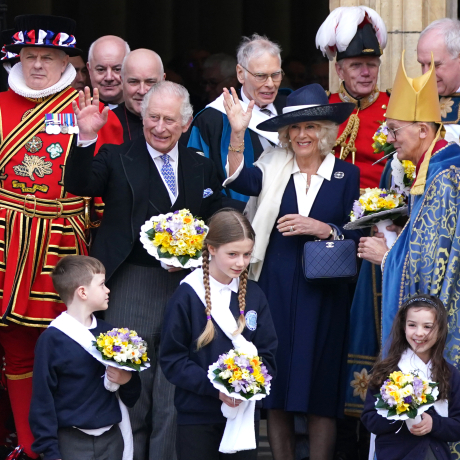
Presentation of Colours
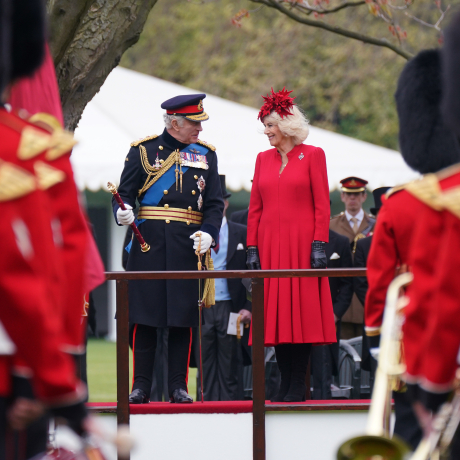
Investitures
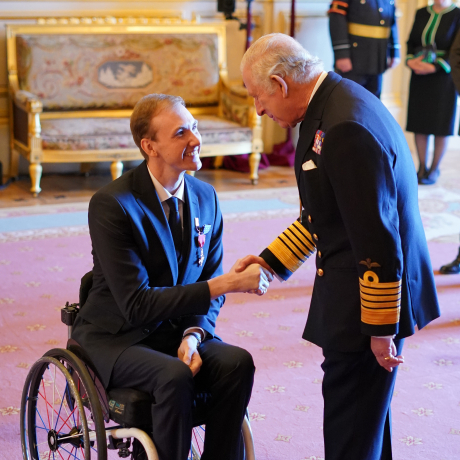
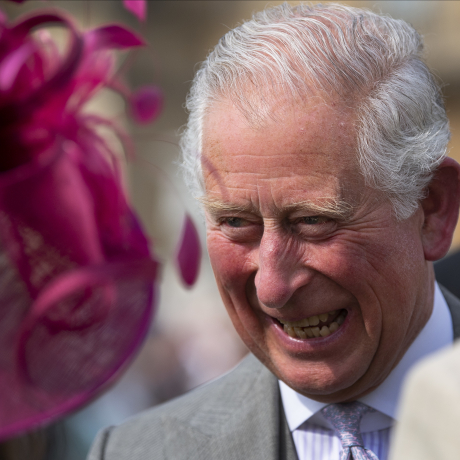
A speech by The Queen at the Borders Railway, Scotland
Inevitably, a long life can pass by many milestones; my own is no exception. But I thank you all, and the many others at home and overseas, for your touching messages of great...
The Duke of Cambridge writes preface to Douglas Hurd's Elizabeth II: The Steadfast
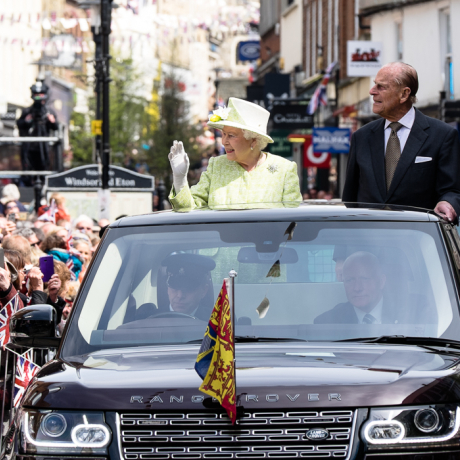
A speech by The Queen at the German State Banquet, 2015
Since 1945 the United Kingdom has determined to number among Germany's very strongest friends in Europe.
Prince Harry has been made a Knight Commander of the Royal Victorian Order
A speech by The Queen at the Women's Institute centenary AGM
In the century since the first W.I. groups were formed in North Wales and in Sussex, so much has changed for women in our society.
The Queen's message to mark the 70th anniversary of the liberation of Guernsey
The Queen's message on the 70th anniversary of liberation of Jersey
The Queen's message marking Prince Harry's secondment to the Australian Diggers
The Queen and members of the Royal Family will attend a Service of Thanksgiving
The Queen's Commonwealth Day Message, 2015
One simple lesson from history is that when people come together to talk, to exchange ideas and to develop common goals, wonderful things can happen.
A speech by The Queen at the Mexico State Banquet, 2015
When the dynamism and creativity of our two countries are combined, whether that be in business, science, education, sport or culture, the results are extraordinary.
Message from The Queen to the new King, King Salman of Saudi Arabia
A speech by The Queen to the Welsh Guards
No hundredth birthday greeting will give greater pleasure to deliver than the one I give to you, along with these New Colours today.
The Queen's message following bush fires in South Australia and Victoria
Christmas Broadcast 2014
For every poppy a life; and a reminder of the grief of loved ones left behind.
A speech by The Queen at the Singapore State Banquet, 2014
Mr. President, your visit is an opportunity to celebrate the links between our two countries, developed over almost two centuries.
A speech by The Queen at Rosyth Dockyard
I name this ship QUEEN ELIZABETH. May God bless her and all who sail in her.
A speech by The Queen at the French State Banquet, 2014
I recall my own happiness, discovering this beautiful country for myself and for the first time, and developing my own great affection for the French people.


